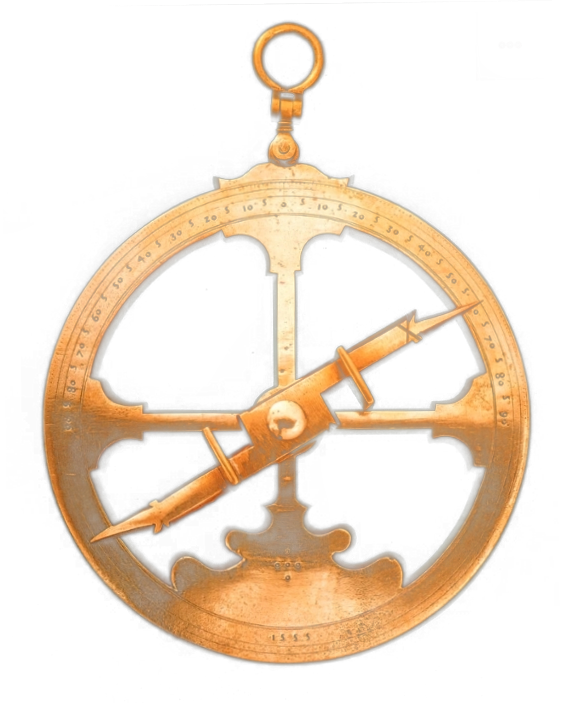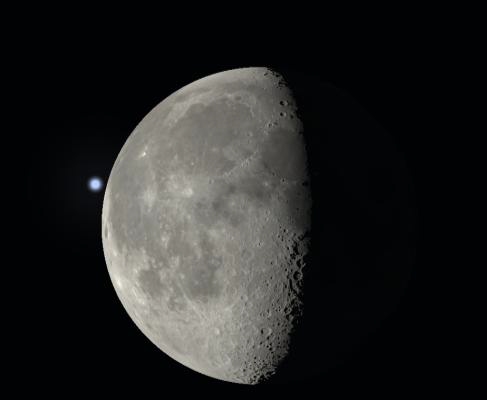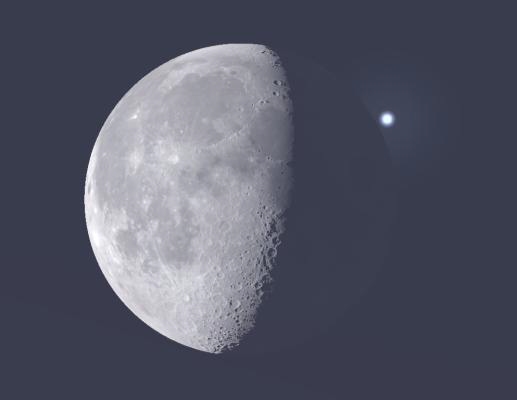Sky Notes for December 2025
Brian Kelly
Director of Observations
Dundee Astronomical Society
From our Director of Observations, Brian Kelly.
THE SKY AT 9 PM GMT IN MID-DECEMBER
The map above shows the night sky as it will appear from central Scotland at the time and date shown. The point in the sky directly overhead is at the centre of the map; the outer circle is the horizon with the cardinal compass points in the direction shown.
The map shows the brighter stars that are visible to the unaided eye. Some of the more distinctive constellations are outlined.
North
West
East
The Moon
The Planets
The Sun
December 1st sunrise 8.21 am GMT sunset 3.39 pm GMT
December 15th sunrise 8.40 am GMT sunset 3.33 pm GMT
December 31st sunrise 8.46 am GMT sunset 3.43 pm GMT
In mid-December, the sky is reasonably dark between 5.00 pm and 7.00 am GMT.
The Sun lies amongst the stars of the constellation of Ophiuchus, the Serpent Bearer, for the first part of December. On Thursday 18th it crosses into Sagittarius where it remains for the rest of the month.
Sunday December 21st is the winter solstice, when the Sun reaches the most southerly point on its annual path around the sky. In central Scotland the Sun is above the horizon for just under 7 hours, and at noon reaches no more than 10o high in the south.
The sunrise, sunset and twilight times given here are for Dundee but generally apply across central Scotland.
December opens with the Moon at a broad gibbous phase, just a few days before Full. On the evening of Wednesday 3rd the Moon lies just to the right of the Pleiades star cluster, and draws closer as the night progresses. In the early hours of Thursday 4th the Moon will pass directly in front of the cluster, occulting the stars; further details are given below.
Full Moon is on the late evening of Thursday December 4th. The Moon rises in the north-east well over an hour before sunset, and shines high in the south among the stars of Taurus at midnight. It sets again in the north-west around an hour-and-a-half after sunrise on Friday 5th.
On the evening of Sunday 7th, the waning gibbous Moon will appear to the left of the bright planet Jupiter and below the stars Castor and Pollux in Gemini. Late on the evening of Tuesday 9th and into the early hours of Wednesday 10th, the Moon will lie immediately to the right of Regulus, the brightest star in Leo. The Moon will occult Regulus at dawn – see details below.
Last Quarter is on the evening of Thursday December 11th; the half Moon rises in the east at midnight and shines in the south at dawn. After this, the waning crescent Moon may be followed into the morning sky, remaining visible at dawn up until Wednesday 17th.
New Moon is on the early morning of Saturday December 20th, and the young crescent Moon will reappear low in the south-west after sunset from Monday 22nd onwards. On Boxing Day evening, Friday 26th, the broad crescent Moon will sit about 4o to the right of the planet Saturn.
First Quarter is on Saturday December 27th, when the half-illuminated Moon will be low in the south in the early evening. It will also be around 10o to the upper left of Saturn.
On New Year’s Eve, Wednesday 31st, the broad gibbous Moon will again appear close to the Pleiades, this time to the left of the star cluster.
Meteors
The Stars
South
Lunar Occultations
At around 0300 UT on the morning of December 4th, the Moon will begin to pass in front of the Pleiades star cluster, occulting the brighter stars. The Moon lies in the centre of the Pleiades at around 0400 UT, when it will be 30o high in the west, and has moved clear again by 0500 UT. However, with the Moon just hours before Full the very bright moonlight may make it difficult to spot the stars of the cluster so close to the Moon’s disc, even with binoculars.
o
Around a week later, on the morning of Wednesday December 10th, the waning gibbous Moon will occult the first-magnitude star Regulus in Leo. At Dundee, the star will disappear behind the bright (left) limb of the Moon’s disc at 0716 UT when the Moon is 39o high in the south-west. Regulus will reappear from the dark (right) limb around an hour later at 0818 UT, with the Moon 32o high in the west-south-west; the sky will however be very bright by this time, with sunrise occurring just 17 minutes later at 0835 UT.
Around a week later, on the morning of Wednesday December 10th, the waning gibbous Moon will occult the first-magnitude star Regulus in Leo. At Dundee, the star will disappear behind the bright (left) limb of the Moon’s disc at 0716 UT when the Moon is 39o high in the south-west. Regulus will reappear from the dark (right) limb around an hour later at 0818 UT, with the Moon 32o high in the west-south-west; the sky will however be very bright by this time, with sunrise occurring just 17 minutes later at 0835 UT.
Mercury is at greatest elongation west from the Sun on December 8th, providing one of its most favourable morning appearances of the year. During the first week of the month Mercury will be rising over two hours before the Sun and may be spotted shining at around magnitude -0.5 low above the south-east horizon in the dawn sky.
Venus rises less than an hour before the Sun at the start of December and just minutes before by the end of the month, so will be hidden from view in the bright dawn glow.
Mars is setting just after the Sun this month and is also lost in the twilight.
Jupiter rises in the north-east shortly before 1900 UT at the beginning of the month and soon after sunset by the end of December. It shines brightly at magnitude -2.6 among the stars of Gemini, to the lower right of Castor and Pollux.
Saturn shines at magnitude 1.0 in the south in the early evening; by the end of the month it is setting in the south-west before midnight.
Uranus lies in western Taurus, about 4.5o to the lower right of the Pleiades. It is easily found in binoculars at magnitude 5.6.
Neptune is in southern Pisces, 4o to the upper left of Saturn, and at magnitude 7.9 can also be seen in binoculars.
The annual Geminid meteor shower is one of the year’s most reliable, regularly producing observed rates of 50-60 meteors per hour at its maximum, which this year falls around dawn on the morning of Sunday December 14th. Highest rates will therefore be seen overnight from Saturday 13th into the 14th; the Moon is a waning crescent and doesn’t rise until 0230 UT so interference from moonlight will be minimal.
The meteors appear to radiate from a point in Gemini near the bright star Castor. The radiant is low in the east early in the evening but climbs to be high in the south in the early hours of the morning; more meteors are therefore likely to be seen after midnight.
Geminid activity starts to build up from early December and declines again just after maximum, so meteors from this shower may be spotted for several nights on either side of the peak itself.
The stars of the ‘Summer Triangle’, Deneb, Vega and Altair are low in the west on December evenings, though Deneb and Vega are far enough north to be followed throughout the night, just clearing the northern horizon during the early hours of the morning.
The little diamond shape of Delphinus the Dolphin is to the upper left of Altair, and the fainter outline of Aquarius the Water Carrier is low in the south-west, with the bright planet Jupiter nearby.
The Square of Pegasus is higher in the south-west; the head and neck of Pegasus lead off to the right, ending the star Enif which marks the flying horse’s nose. The stars of Andromeda extend from the opposite corner of the Square, leading to the stars of Perseus. Almost overhead are the constellations of Cassiopeia and Cepheus.
Below Andromeda are two small but distinctive constellations – Triangulum the Triangle and Aries, the Ram. The southern sky is largely filled by the fainter and less obvious pattern of Cetus, the whale.
The bright constellations of winter are now visible in the south-east. Orion the Hunter is the most prominent, with his three Belt stars accompanied by orange-coloured Betelgeuse and blue-white Rigel. The V-shaped head of Taurus the Bull is to Orion’s upper right, with another red giant star, Aldebaran, marking the bull’s eye; slightly higher are the stars of the Pleiades or Seven Sisters cluster.
Auriga the Charioteer is high above Orion, its brightest star Capella almost overhead, and Gemini with its Twin stars of Castor and Pollux is well up in the east. Below Gemini is the bright white star Procyon, also known as the Little Dog Star.
Circling the Pole Star are the circumpolar stars – on December evenings the Plough is slowly climbing higher in the north-east while the ‘W’ shape of Cassiopeia stands almost overhead. The faint pattern of Ursa Minor, the Little Bear, curves from the Pole Star towards the Plough.
The Milky Way crosses overhead from south-east to north-west, running through Gemini, Orion and Auriga into Perseus and Cassiopeia and down through Cygnus. Moonless winter evenings are ideal for exploring the many clusters and starfields that lie along the extent of the Milky Way.
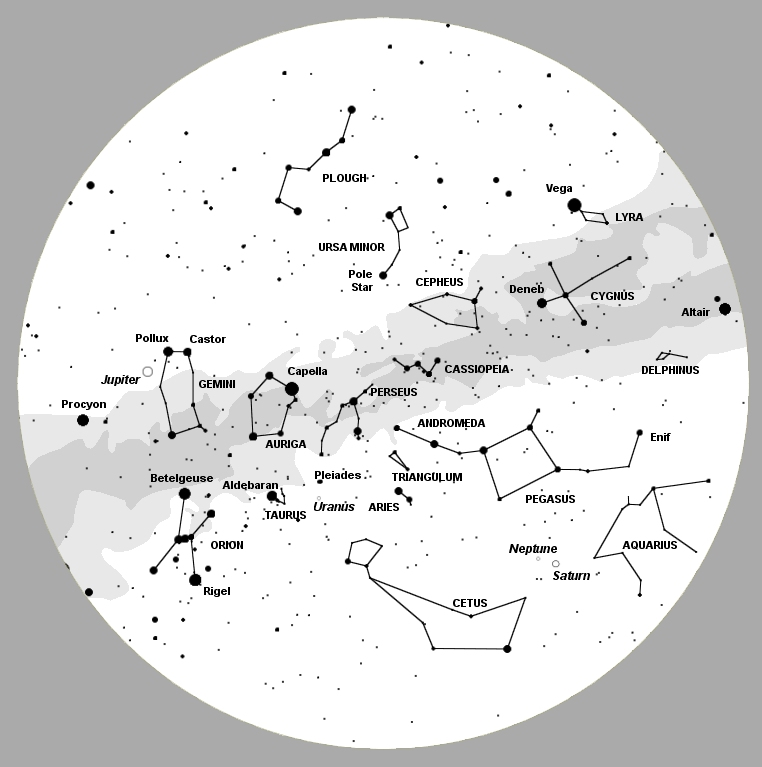
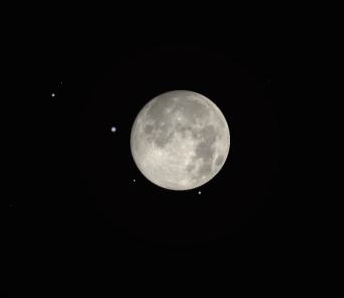
Moon and Pleiades at 0400 UT
Disappearance at bright limb 0716 UT Reappearance at dark limb 0818 UT
